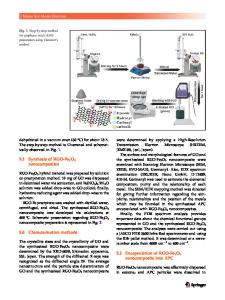A novel Fe 2 O 3 rhombohedra/graphene composite as a high stability electrode for lithium-ion batteries
- PDF / 676,109 Bytes
- 9 Pages / 584.957 x 782.986 pts Page_size
- 63 Downloads / 337 Views
Lifeng Bian and Manhtai Nguyen Key Laboratory of Nanodevices and Applications, Suzhou Institute of Nano-Tech and Nano-Bionics, Chinese Academy of Sciences, Suzhou 215123, Jiangsu, China
Yuliang Chu Instrumental Analysis and Research Center, Shanghai University, Shanghai 200444, China
Bing Zhaoa) School of Environmental and Chemical Engineering, Shanghai University, Shanghai 200444, China (Received 13 August 2014; accepted 10 February 2015)
We demonstrate in this paper the shape-controlled synthesis of a-Fe2O3 rhombohedra anchored graphene nanocomposites through a simple hydrothermal strategy by adopting inorganic species in the synthesis system. TEM investigations reveal that the rhombohedra with an average diameter of 80 nm is formed through oriented attachment of primary nanocrystals assisted by Ostwald ripening, and CH3COONa inorganic surfactant played an important role in control over the final morphology of the products. As high-performance anodes for lithium-ion batteries, the obtained Fe2O3 rhombohedra/graphene composite exhibits the first reversible capacity of 905.3 mAh g 1, and high capacity retention of 85.7% after 50 cycles. These values are much higher than those of bare Fe2O3 and Fe2O3 particle/graphene composites, indicating its excellent electrochemical stability. These results give us a guideline for the study of the morphology-dependent properties of functional oxide materials as well as further applications for magnetic materials, lithium-ion batteries, and gas sensors.
I. INTRODUCTION
Hematite (a-Fe2O3), based on hexagonal close packing of oxygen with iron in 2/3 of the octahedral vacancies, is traditionally used as catalysts, pigments, gas sensors, and electrode materials due to its attractive features, such as low cost, good stability, nontoxicity, and environmentally friendly properties. 1,2 Particularly, the compound has a theoretical capacity of 1007 mAh g 1, 2.7 times higher than that of commercial graphite (372 mAh g 1 ), thus becomes a kind of candidates for the high capacity lithium-ion battery anode materials. For instance, nanocubes, nanorods, nanotubes, hollow spheres, porous nanospheres, nanorings, and hexapod-like nanostructures of a-Fe2 O3 have been synthesized and were used as electroactive materials. 3–5 However, the poor electrical conductivity and large volume change, pulverization/aggregation of Fe 2 O3 nanostructures during lithium insertion/extraction result in a large capacity loss and poor cycling stability. 6
Contributing Editor: Xiabo Chen a) Address all correspondence to this author. e-mail: [email protected] DOI: 10.1557/jmr.2015.35 J. Mater. Res., 2015
http://journals.cambridge.org
Downloaded: 03 Mar 2015
Strategies have been proposed to mitigate the pulverization and further enhance the structural stability of hematite electrode materials. (i) Designing unique micro/nanostructures or controlling pore structures of hematite is an effective path to reduce the absolute volume change and offer a shorter diffusion length for lithium ion leading to enhanced discharg
Data Loading...











